Improving Transit Service Efficiency and Safety
VerifiedAdded on 2020/04/21
|18
|5283
|59
AI Summary
This assignment examines the application of connected vehicle infrastructure technologies to enhance the efficiency and safety of public transit systems. It delves into specific applications and their potential benefits, aiming to shed light on how these advancements can revolutionize the way we manage and experience urban transportation.
Contribute Materials
Your contribution can guide someone’s learning journey. Share your
documents today.
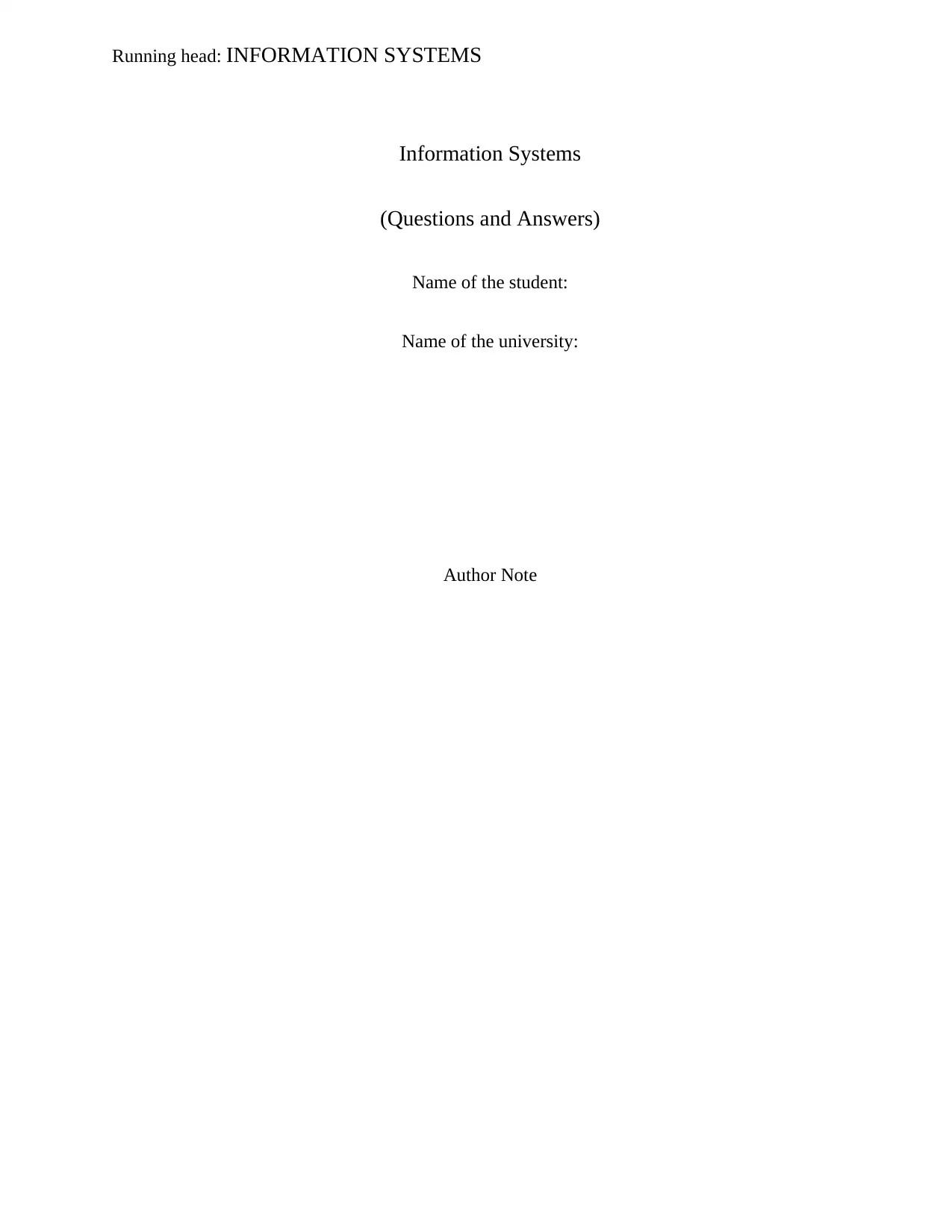
Running head: INFORMATION SYSTEMS
Information Systems
(Questions and Answers)
Name of the student:
Name of the university:
Author Note
Information Systems
(Questions and Answers)
Name of the student:
Name of the university:
Author Note
Secure Best Marks with AI Grader
Need help grading? Try our AI Grader for instant feedback on your assignments.
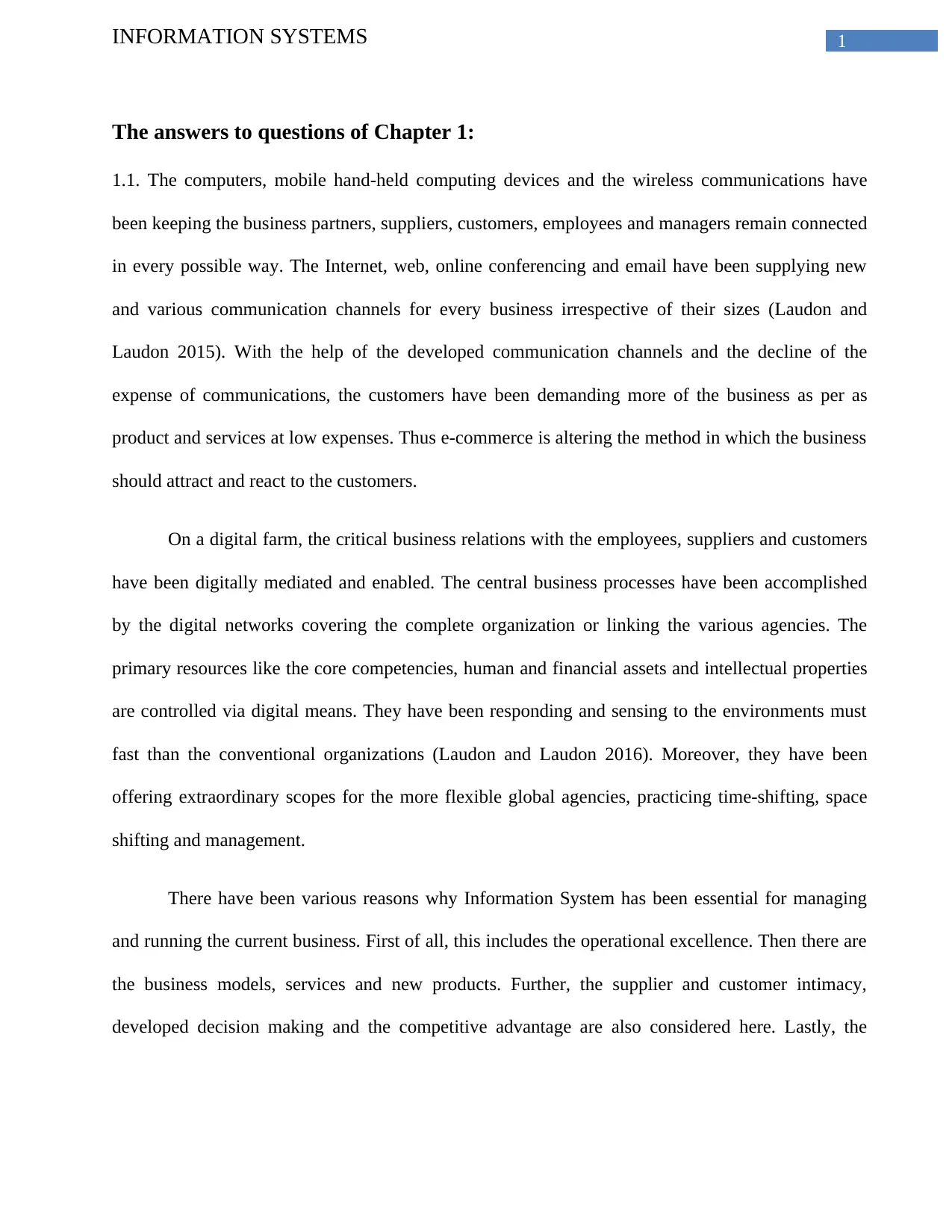
1INFORMATION SYSTEMS
The answers to questions of Chapter 1:
1.1. The computers, mobile hand-held computing devices and the wireless communications have
been keeping the business partners, suppliers, customers, employees and managers remain connected
in every possible way. The Internet, web, online conferencing and email have been supplying new
and various communication channels for every business irrespective of their sizes (Laudon and
Laudon 2015). With the help of the developed communication channels and the decline of the
expense of communications, the customers have been demanding more of the business as per as
product and services at low expenses. Thus e-commerce is altering the method in which the business
should attract and react to the customers.
On a digital farm, the critical business relations with the employees, suppliers and customers
have been digitally mediated and enabled. The central business processes have been accomplished
by the digital networks covering the complete organization or linking the various agencies. The
primary resources like the core competencies, human and financial assets and intellectual properties
are controlled via digital means. They have been responding and sensing to the environments must
fast than the conventional organizations (Laudon and Laudon 2016). Moreover, they have been
offering extraordinary scopes for the more flexible global agencies, practicing time-shifting, space
shifting and management.
There have been various reasons why Information System has been essential for managing
and running the current business. First of all, this includes the operational excellence. Then there are
the business models, services and new products. Further, the supplier and customer intimacy,
developed decision making and the competitive advantage are also considered here. Lastly, the
The answers to questions of Chapter 1:
1.1. The computers, mobile hand-held computing devices and the wireless communications have
been keeping the business partners, suppliers, customers, employees and managers remain connected
in every possible way. The Internet, web, online conferencing and email have been supplying new
and various communication channels for every business irrespective of their sizes (Laudon and
Laudon 2015). With the help of the developed communication channels and the decline of the
expense of communications, the customers have been demanding more of the business as per as
product and services at low expenses. Thus e-commerce is altering the method in which the business
should attract and react to the customers.
On a digital farm, the critical business relations with the employees, suppliers and customers
have been digitally mediated and enabled. The central business processes have been accomplished
by the digital networks covering the complete organization or linking the various agencies. The
primary resources like the core competencies, human and financial assets and intellectual properties
are controlled via digital means. They have been responding and sensing to the environments must
fast than the conventional organizations (Laudon and Laudon 2016). Moreover, they have been
offering extraordinary scopes for the more flexible global agencies, practicing time-shifting, space
shifting and management.
There have been various reasons why Information System has been essential for managing
and running the current business. First of all, this includes the operational excellence. Then there are
the business models, services and new products. Further, the supplier and customer intimacy,
developed decision making and the competitive advantage are also considered here. Lastly, the
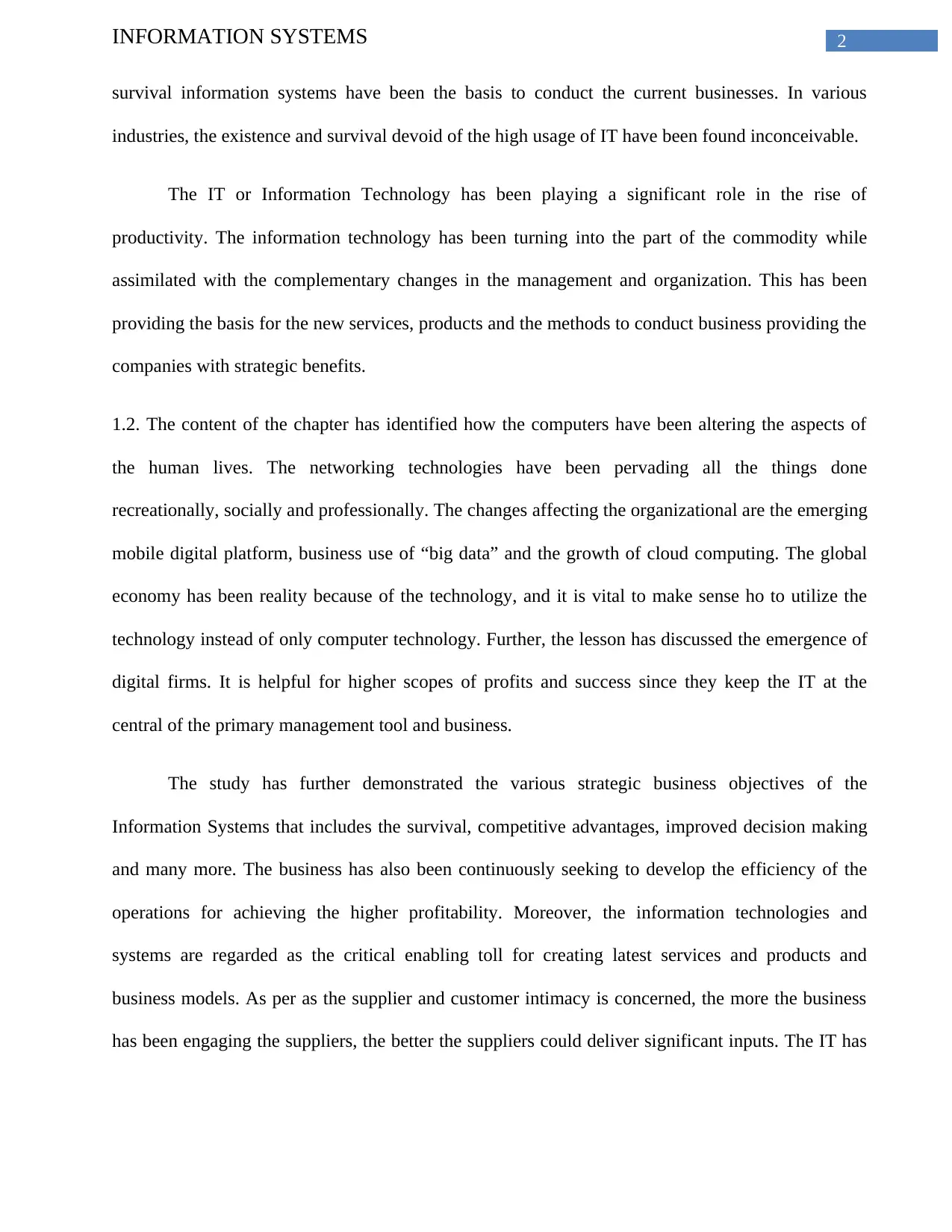
2INFORMATION SYSTEMS
survival information systems have been the basis to conduct the current businesses. In various
industries, the existence and survival devoid of the high usage of IT have been found inconceivable.
The IT or Information Technology has been playing a significant role in the rise of
productivity. The information technology has been turning into the part of the commodity while
assimilated with the complementary changes in the management and organization. This has been
providing the basis for the new services, products and the methods to conduct business providing the
companies with strategic benefits.
1.2. The content of the chapter has identified how the computers have been altering the aspects of
the human lives. The networking technologies have been pervading all the things done
recreationally, socially and professionally. The changes affecting the organizational are the emerging
mobile digital platform, business use of “big data” and the growth of cloud computing. The global
economy has been reality because of the technology, and it is vital to make sense ho to utilize the
technology instead of only computer technology. Further, the lesson has discussed the emergence of
digital firms. It is helpful for higher scopes of profits and success since they keep the IT at the
central of the primary management tool and business.
The study has further demonstrated the various strategic business objectives of the
Information Systems that includes the survival, competitive advantages, improved decision making
and many more. The business has also been continuously seeking to develop the efficiency of the
operations for achieving the higher profitability. Moreover, the information technologies and
systems are regarded as the critical enabling toll for creating latest services and products and
business models. As per as the supplier and customer intimacy is concerned, the more the business
has been engaging the suppliers, the better the suppliers could deliver significant inputs. The IT has
survival information systems have been the basis to conduct the current businesses. In various
industries, the existence and survival devoid of the high usage of IT have been found inconceivable.
The IT or Information Technology has been playing a significant role in the rise of
productivity. The information technology has been turning into the part of the commodity while
assimilated with the complementary changes in the management and organization. This has been
providing the basis for the new services, products and the methods to conduct business providing the
companies with strategic benefits.
1.2. The content of the chapter has identified how the computers have been altering the aspects of
the human lives. The networking technologies have been pervading all the things done
recreationally, socially and professionally. The changes affecting the organizational are the emerging
mobile digital platform, business use of “big data” and the growth of cloud computing. The global
economy has been reality because of the technology, and it is vital to make sense ho to utilize the
technology instead of only computer technology. Further, the lesson has discussed the emergence of
digital firms. It is helpful for higher scopes of profits and success since they keep the IT at the
central of the primary management tool and business.
The study has further demonstrated the various strategic business objectives of the
Information Systems that includes the survival, competitive advantages, improved decision making
and many more. The business has also been continuously seeking to develop the efficiency of the
operations for achieving the higher profitability. Moreover, the information technologies and
systems are regarded as the critical enabling toll for creating latest services and products and
business models. As per as the supplier and customer intimacy is concerned, the more the business
has been engaging the suppliers, the better the suppliers could deliver significant inputs. The IT has

3INFORMATION SYSTEMS
been helpful for the managers to utilize the real-time data from the market along with making
decisions (Bovee, Thill and Raina 2016).
The chapter also shows that the performing activities better than the competitors, reacting to
the suppliers and customers in the real time and charging less for the superior products has been
adding up higher sales and profits that are unmatchable for the competitors. Lastly, the study ends
with the discussing the socio-technical approach and everybody needs to work together to assure that
the information system has been serving the complete organization.
The answer to the questions of Chapter 2:
2.1. The business process has been related logically to the various acts defining how particular the
tasks of the business are done. It is the way by which the agencies organize and coordinate various
knowledge, information and activities for producing the valuable services and products.
The positive impact of the business depends on the way in which the business processes are
coordinated and designed. On the other hand, the poorly executed or designed process of business
has been the liability as they are by outdated methods of working along with impeding efficiency
and responsiveness (Wiengarten et al. 2013).
The information systems have been automating the business processes manually and making
the companies more efficient. The information and data are present to an extensive range of decision
makers faster as the information systems are utilized to alter the information flow. The tasks could
be done at the same time instead of speeding up the finishing of business process sequentially. They
could also drive new models of business that could not have been possible instead of the technology.
2.2. The systems serving the operational management are the TPS or transaction processing systems
like the order processing and payroll. This tracks the flow of the routine transactions needed to
been helpful for the managers to utilize the real-time data from the market along with making
decisions (Bovee, Thill and Raina 2016).
The chapter also shows that the performing activities better than the competitors, reacting to
the suppliers and customers in the real time and charging less for the superior products has been
adding up higher sales and profits that are unmatchable for the competitors. Lastly, the study ends
with the discussing the socio-technical approach and everybody needs to work together to assure that
the information system has been serving the complete organization.
The answer to the questions of Chapter 2:
2.1. The business process has been related logically to the various acts defining how particular the
tasks of the business are done. It is the way by which the agencies organize and coordinate various
knowledge, information and activities for producing the valuable services and products.
The positive impact of the business depends on the way in which the business processes are
coordinated and designed. On the other hand, the poorly executed or designed process of business
has been the liability as they are by outdated methods of working along with impeding efficiency
and responsiveness (Wiengarten et al. 2013).
The information systems have been automating the business processes manually and making
the companies more efficient. The information and data are present to an extensive range of decision
makers faster as the information systems are utilized to alter the information flow. The tasks could
be done at the same time instead of speeding up the finishing of business process sequentially. They
could also drive new models of business that could not have been possible instead of the technology.
2.2. The systems serving the operational management are the TPS or transaction processing systems
like the order processing and payroll. This tracks the flow of the routine transactions needed to
Secure Best Marks with AI Grader
Need help grading? Try our AI Grader for instant feedback on your assignments.

4INFORMATION SYSTEMS
conduct the business. The MIS or Management Information System has been producing reports
serving the middle management by decreasing the data from the TPS and has been largely analytical.
The DSS or decision support systems have been supporting the management decisions that
are distinct and changing fast using the analytical and advanced models. Every kind of the systems
has been providing the business intelligence helping the enterprise employees and managers make
more informed decisions (Chi, Zhao and George 2015). The systems for the business intelligence has
been serving the various levels and managements and including the ESS or executive support
systems for the senior management. This has been providing data in graphical formats, dashboards
and charts delivered through portals using various sources of external and internal information.
2.3. The enterprise applications have been designed for coordinating the various business processes
and functions. The systems of an enterprise have been integrating the primary processes of internal
business of the organization into one software system for improving the decision making and
coordination. The supply chain management system has been helping the organization to manage the
different relationship with the suppliers. This is for optimizing the sourcing, The CRM and customer
relationship management system has been coordinating the processes of business encircling the
customers of the firm. The knowledge management system has been enabling the company to enable
the firms in optimizing the distribution, sharing and creation of knowledge (Nof et al. 2015). The
extranets and intranets are the private corporate networks by Internet technology. It has been
assembling the information from the disparate systems. The extranets have been making the portions
of the private corporate intranets being available to the external agents.
2.4. The collaboration has been performing the activities with the others for achieving the explicit
and shared goals. The teamwork and collaboration have been highly crucial in business due to
globalization, decentralization of the decision making and the growth in the jobs where the
conduct the business. The MIS or Management Information System has been producing reports
serving the middle management by decreasing the data from the TPS and has been largely analytical.
The DSS or decision support systems have been supporting the management decisions that
are distinct and changing fast using the analytical and advanced models. Every kind of the systems
has been providing the business intelligence helping the enterprise employees and managers make
more informed decisions (Chi, Zhao and George 2015). The systems for the business intelligence has
been serving the various levels and managements and including the ESS or executive support
systems for the senior management. This has been providing data in graphical formats, dashboards
and charts delivered through portals using various sources of external and internal information.
2.3. The enterprise applications have been designed for coordinating the various business processes
and functions. The systems of an enterprise have been integrating the primary processes of internal
business of the organization into one software system for improving the decision making and
coordination. The supply chain management system has been helping the organization to manage the
different relationship with the suppliers. This is for optimizing the sourcing, The CRM and customer
relationship management system has been coordinating the processes of business encircling the
customers of the firm. The knowledge management system has been enabling the company to enable
the firms in optimizing the distribution, sharing and creation of knowledge (Nof et al. 2015). The
extranets and intranets are the private corporate networks by Internet technology. It has been
assembling the information from the disparate systems. The extranets have been making the portions
of the private corporate intranets being available to the external agents.
2.4. The collaboration has been performing the activities with the others for achieving the explicit
and shared goals. The teamwork and collaboration have been highly crucial in business due to
globalization, decentralization of the decision making and the growth in the jobs where the
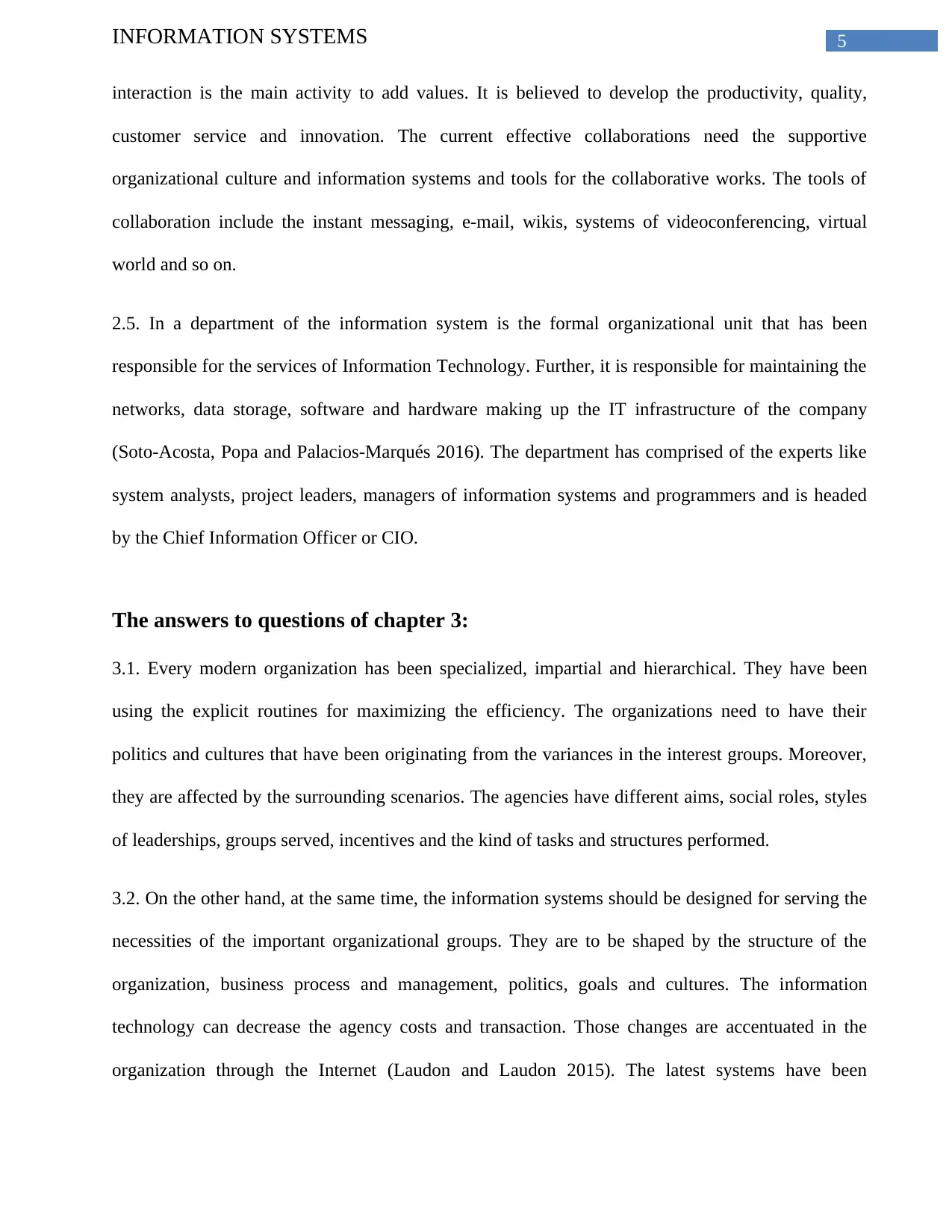
5INFORMATION SYSTEMS
interaction is the main activity to add values. It is believed to develop the productivity, quality,
customer service and innovation. The current effective collaborations need the supportive
organizational culture and information systems and tools for the collaborative works. The tools of
collaboration include the instant messaging, e-mail, wikis, systems of videoconferencing, virtual
world and so on.
2.5. In a department of the information system is the formal organizational unit that has been
responsible for the services of Information Technology. Further, it is responsible for maintaining the
networks, data storage, software and hardware making up the IT infrastructure of the company
(Soto-Acosta, Popa and Palacios-Marqués 2016). The department has comprised of the experts like
system analysts, project leaders, managers of information systems and programmers and is headed
by the Chief Information Officer or CIO.
The answers to questions of chapter 3:
3.1. Every modern organization has been specialized, impartial and hierarchical. They have been
using the explicit routines for maximizing the efficiency. The organizations need to have their
politics and cultures that have been originating from the variances in the interest groups. Moreover,
they are affected by the surrounding scenarios. The agencies have different aims, social roles, styles
of leaderships, groups served, incentives and the kind of tasks and structures performed.
3.2. On the other hand, at the same time, the information systems should be designed for serving the
necessities of the important organizational groups. They are to be shaped by the structure of the
organization, business process and management, politics, goals and cultures. The information
technology can decrease the agency costs and transaction. Those changes are accentuated in the
organization through the Internet (Laudon and Laudon 2015). The latest systems have been
interaction is the main activity to add values. It is believed to develop the productivity, quality,
customer service and innovation. The current effective collaborations need the supportive
organizational culture and information systems and tools for the collaborative works. The tools of
collaboration include the instant messaging, e-mail, wikis, systems of videoconferencing, virtual
world and so on.
2.5. In a department of the information system is the formal organizational unit that has been
responsible for the services of Information Technology. Further, it is responsible for maintaining the
networks, data storage, software and hardware making up the IT infrastructure of the company
(Soto-Acosta, Popa and Palacios-Marqués 2016). The department has comprised of the experts like
system analysts, project leaders, managers of information systems and programmers and is headed
by the Chief Information Officer or CIO.
The answers to questions of chapter 3:
3.1. Every modern organization has been specialized, impartial and hierarchical. They have been
using the explicit routines for maximizing the efficiency. The organizations need to have their
politics and cultures that have been originating from the variances in the interest groups. Moreover,
they are affected by the surrounding scenarios. The agencies have different aims, social roles, styles
of leaderships, groups served, incentives and the kind of tasks and structures performed.
3.2. On the other hand, at the same time, the information systems should be designed for serving the
necessities of the important organizational groups. They are to be shaped by the structure of the
organization, business process and management, politics, goals and cultures. The information
technology can decrease the agency costs and transaction. Those changes are accentuated in the
organization through the Internet (Laudon and Laudon 2015). The latest systems have been
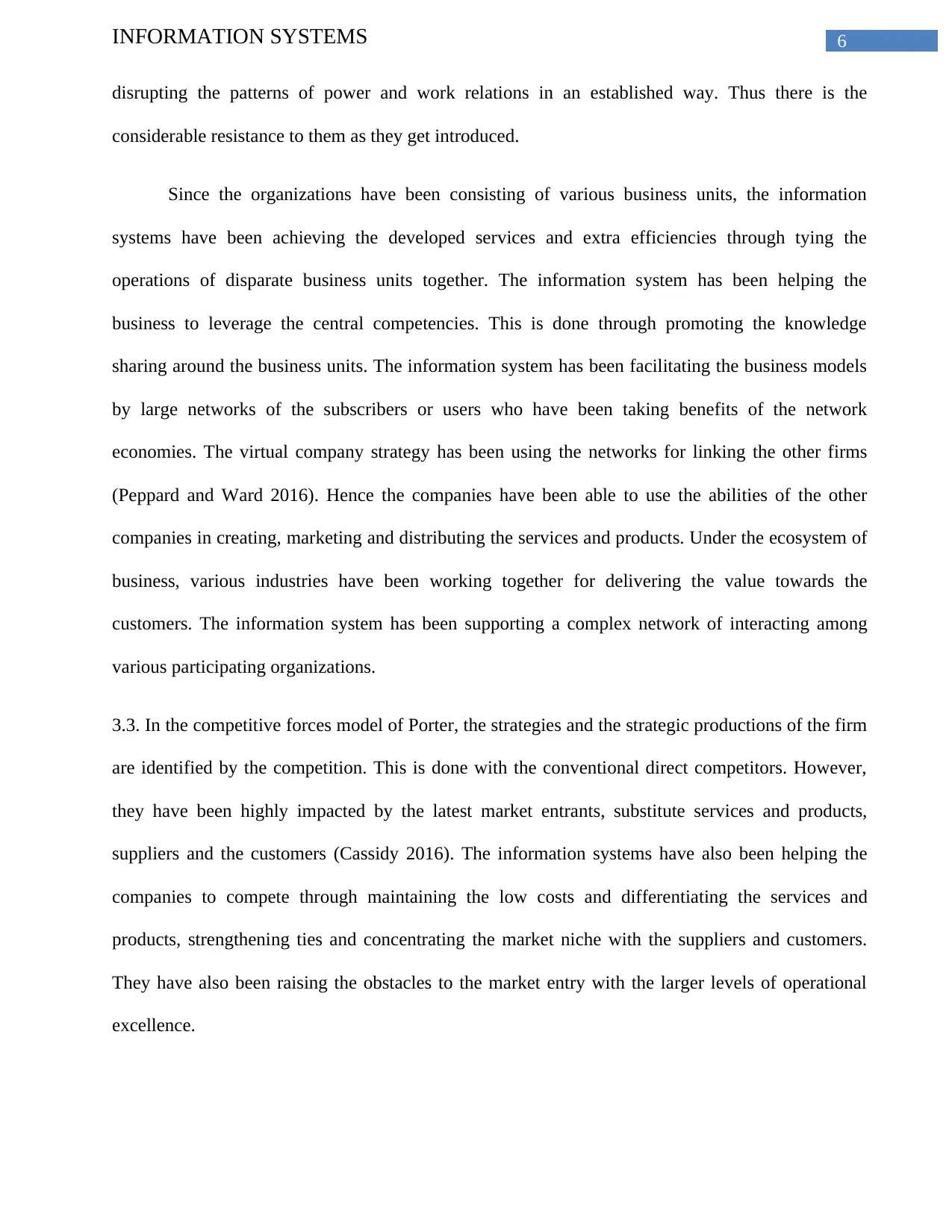
6INFORMATION SYSTEMS
disrupting the patterns of power and work relations in an established way. Thus there is the
considerable resistance to them as they get introduced.
Since the organizations have been consisting of various business units, the information
systems have been achieving the developed services and extra efficiencies through tying the
operations of disparate business units together. The information system has been helping the
business to leverage the central competencies. This is done through promoting the knowledge
sharing around the business units. The information system has been facilitating the business models
by large networks of the subscribers or users who have been taking benefits of the network
economies. The virtual company strategy has been using the networks for linking the other firms
(Peppard and Ward 2016). Hence the companies have been able to use the abilities of the other
companies in creating, marketing and distributing the services and products. Under the ecosystem of
business, various industries have been working together for delivering the value towards the
customers. The information system has been supporting a complex network of interacting among
various participating organizations.
3.3. In the competitive forces model of Porter, the strategies and the strategic productions of the firm
are identified by the competition. This is done with the conventional direct competitors. However,
they have been highly impacted by the latest market entrants, substitute services and products,
suppliers and the customers (Cassidy 2016). The information systems have also been helping the
companies to compete through maintaining the low costs and differentiating the services and
products, strengthening ties and concentrating the market niche with the suppliers and customers.
They have also been raising the obstacles to the market entry with the larger levels of operational
excellence.
disrupting the patterns of power and work relations in an established way. Thus there is the
considerable resistance to them as they get introduced.
Since the organizations have been consisting of various business units, the information
systems have been achieving the developed services and extra efficiencies through tying the
operations of disparate business units together. The information system has been helping the
business to leverage the central competencies. This is done through promoting the knowledge
sharing around the business units. The information system has been facilitating the business models
by large networks of the subscribers or users who have been taking benefits of the network
economies. The virtual company strategy has been using the networks for linking the other firms
(Peppard and Ward 2016). Hence the companies have been able to use the abilities of the other
companies in creating, marketing and distributing the services and products. Under the ecosystem of
business, various industries have been working together for delivering the value towards the
customers. The information system has been supporting a complex network of interacting among
various participating organizations.
3.3. In the competitive forces model of Porter, the strategies and the strategic productions of the firm
are identified by the competition. This is done with the conventional direct competitors. However,
they have been highly impacted by the latest market entrants, substitute services and products,
suppliers and the customers (Cassidy 2016). The information systems have also been helping the
companies to compete through maintaining the low costs and differentiating the services and
products, strengthening ties and concentrating the market niche with the suppliers and customers.
They have also been raising the obstacles to the market entry with the larger levels of operational
excellence.
Paraphrase This Document
Need a fresh take? Get an instant paraphrase of this document with our AI Paraphraser
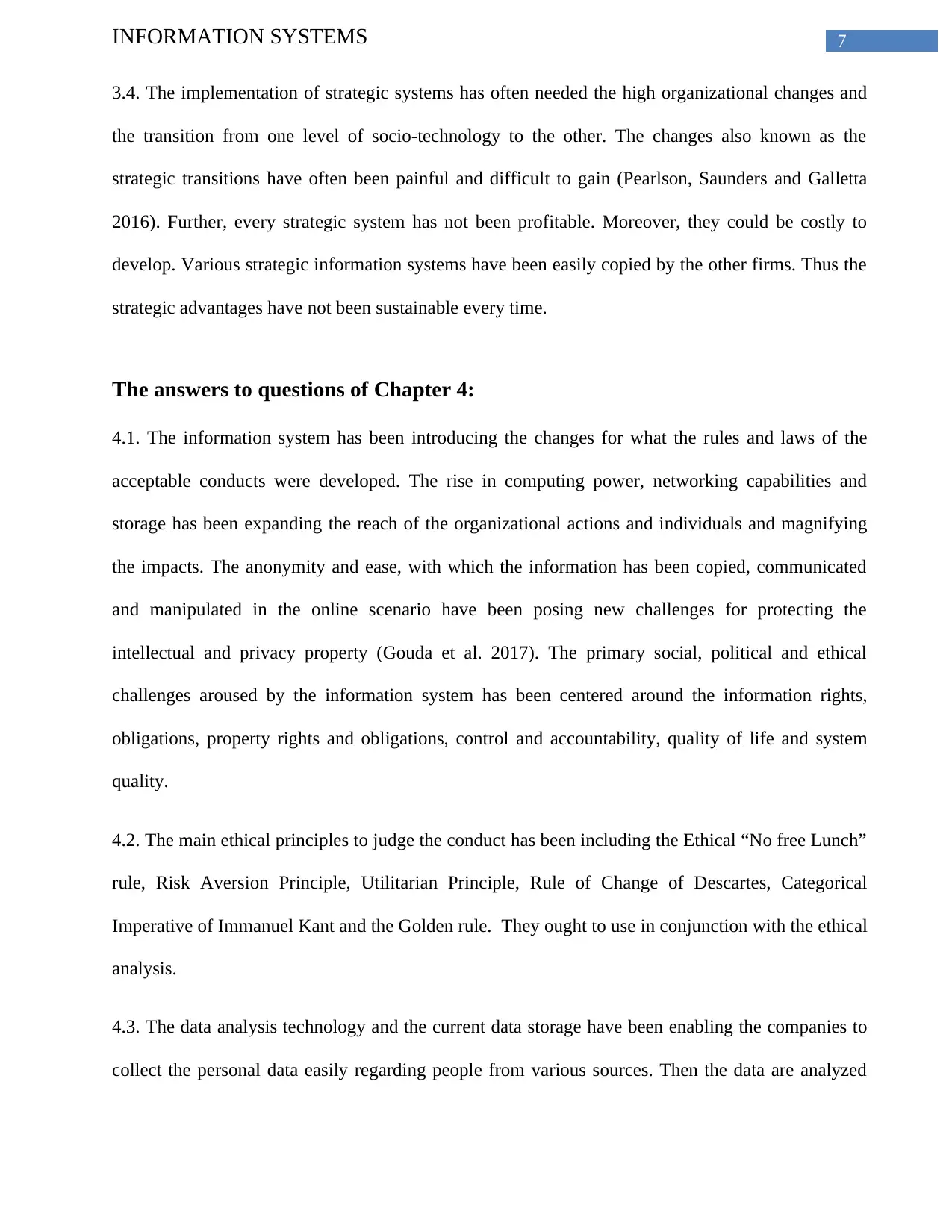
7INFORMATION SYSTEMS
3.4. The implementation of strategic systems has often needed the high organizational changes and
the transition from one level of socio-technology to the other. The changes also known as the
strategic transitions have often been painful and difficult to gain (Pearlson, Saunders and Galletta
2016). Further, every strategic system has not been profitable. Moreover, they could be costly to
develop. Various strategic information systems have been easily copied by the other firms. Thus the
strategic advantages have not been sustainable every time.
The answers to questions of Chapter 4:
4.1. The information system has been introducing the changes for what the rules and laws of the
acceptable conducts were developed. The rise in computing power, networking capabilities and
storage has been expanding the reach of the organizational actions and individuals and magnifying
the impacts. The anonymity and ease, with which the information has been copied, communicated
and manipulated in the online scenario have been posing new challenges for protecting the
intellectual and privacy property (Gouda et al. 2017). The primary social, political and ethical
challenges aroused by the information system has been centered around the information rights,
obligations, property rights and obligations, control and accountability, quality of life and system
quality.
4.2. The main ethical principles to judge the conduct has been including the Ethical “No free Lunch”
rule, Risk Aversion Principle, Utilitarian Principle, Rule of Change of Descartes, Categorical
Imperative of Immanuel Kant and the Golden rule. They ought to use in conjunction with the ethical
analysis.
4.3. The data analysis technology and the current data storage have been enabling the companies to
collect the personal data easily regarding people from various sources. Then the data are analyzed
3.4. The implementation of strategic systems has often needed the high organizational changes and
the transition from one level of socio-technology to the other. The changes also known as the
strategic transitions have often been painful and difficult to gain (Pearlson, Saunders and Galletta
2016). Further, every strategic system has not been profitable. Moreover, they could be costly to
develop. Various strategic information systems have been easily copied by the other firms. Thus the
strategic advantages have not been sustainable every time.
The answers to questions of Chapter 4:
4.1. The information system has been introducing the changes for what the rules and laws of the
acceptable conducts were developed. The rise in computing power, networking capabilities and
storage has been expanding the reach of the organizational actions and individuals and magnifying
the impacts. The anonymity and ease, with which the information has been copied, communicated
and manipulated in the online scenario have been posing new challenges for protecting the
intellectual and privacy property (Gouda et al. 2017). The primary social, political and ethical
challenges aroused by the information system has been centered around the information rights,
obligations, property rights and obligations, control and accountability, quality of life and system
quality.
4.2. The main ethical principles to judge the conduct has been including the Ethical “No free Lunch”
rule, Risk Aversion Principle, Utilitarian Principle, Rule of Change of Descartes, Categorical
Imperative of Immanuel Kant and the Golden rule. They ought to use in conjunction with the ethical
analysis.
4.3. The data analysis technology and the current data storage have been enabling the companies to
collect the personal data easily regarding people from various sources. Then the data are analyzed

8INFORMATION SYSTEMS
for creating in-depth electronic profiles regarding the people and their different behaviors. The data
flowing on the Internet has been monitored at various points (Kosinski et al. 2015). The cookies and
the other web monitoring tools have been closely tracking the tasks of web site visitors. Every
website has been possessing strong policies of privacy protection. They have not always been
permitted for the informed consent about the usage of personal data. The conventional laws of
copyright have been not enough to protect against the software piracy. This is due to the digital
material that could be copied with ease and transferred to various locations on the Internet at the
same time.
4.4. Though the computer systems have been the origin of wealth and efficiency, there have been
few negative effects also. The computer errors have been causing serious harms to the organizations
and people. The poor quality of data has also been playing the role of losses and disruptions for the
business. The efficiency to use and own the computer has been exacerbating the socioeconomic
disparities lying among various economic, ethnic and racial groups and the social classes (McKee
2013). The widespread usage of computers has been raising the scopes for the computer abuse and
computer crime. The computers have also been creating the health problems like RSI (Repetitive
Strain Injury), the techno-stress and the computer vision syndrome.
The answers to the question of Chapter 5:
5.1. The IT infrastructure is regarded as the shared resources of technology providing the platform
for the specific information of the organization’s system applications. This includes the services,
software, hardware shared around the complete organization. The main IT infrastructure elements
are the computer hardware platforms, enterprise software platforms, operating system platforms,
networking and telecommunication platforms, database management software, consulting services,
systems integrators and Internet platforms.
for creating in-depth electronic profiles regarding the people and their different behaviors. The data
flowing on the Internet has been monitored at various points (Kosinski et al. 2015). The cookies and
the other web monitoring tools have been closely tracking the tasks of web site visitors. Every
website has been possessing strong policies of privacy protection. They have not always been
permitted for the informed consent about the usage of personal data. The conventional laws of
copyright have been not enough to protect against the software piracy. This is due to the digital
material that could be copied with ease and transferred to various locations on the Internet at the
same time.
4.4. Though the computer systems have been the origin of wealth and efficiency, there have been
few negative effects also. The computer errors have been causing serious harms to the organizations
and people. The poor quality of data has also been playing the role of losses and disruptions for the
business. The efficiency to use and own the computer has been exacerbating the socioeconomic
disparities lying among various economic, ethnic and racial groups and the social classes (McKee
2013). The widespread usage of computers has been raising the scopes for the computer abuse and
computer crime. The computers have also been creating the health problems like RSI (Repetitive
Strain Injury), the techno-stress and the computer vision syndrome.
The answers to the question of Chapter 5:
5.1. The IT infrastructure is regarded as the shared resources of technology providing the platform
for the specific information of the organization’s system applications. This includes the services,
software, hardware shared around the complete organization. The main IT infrastructure elements
are the computer hardware platforms, enterprise software platforms, operating system platforms,
networking and telecommunication platforms, database management software, consulting services,
systems integrators and Internet platforms.
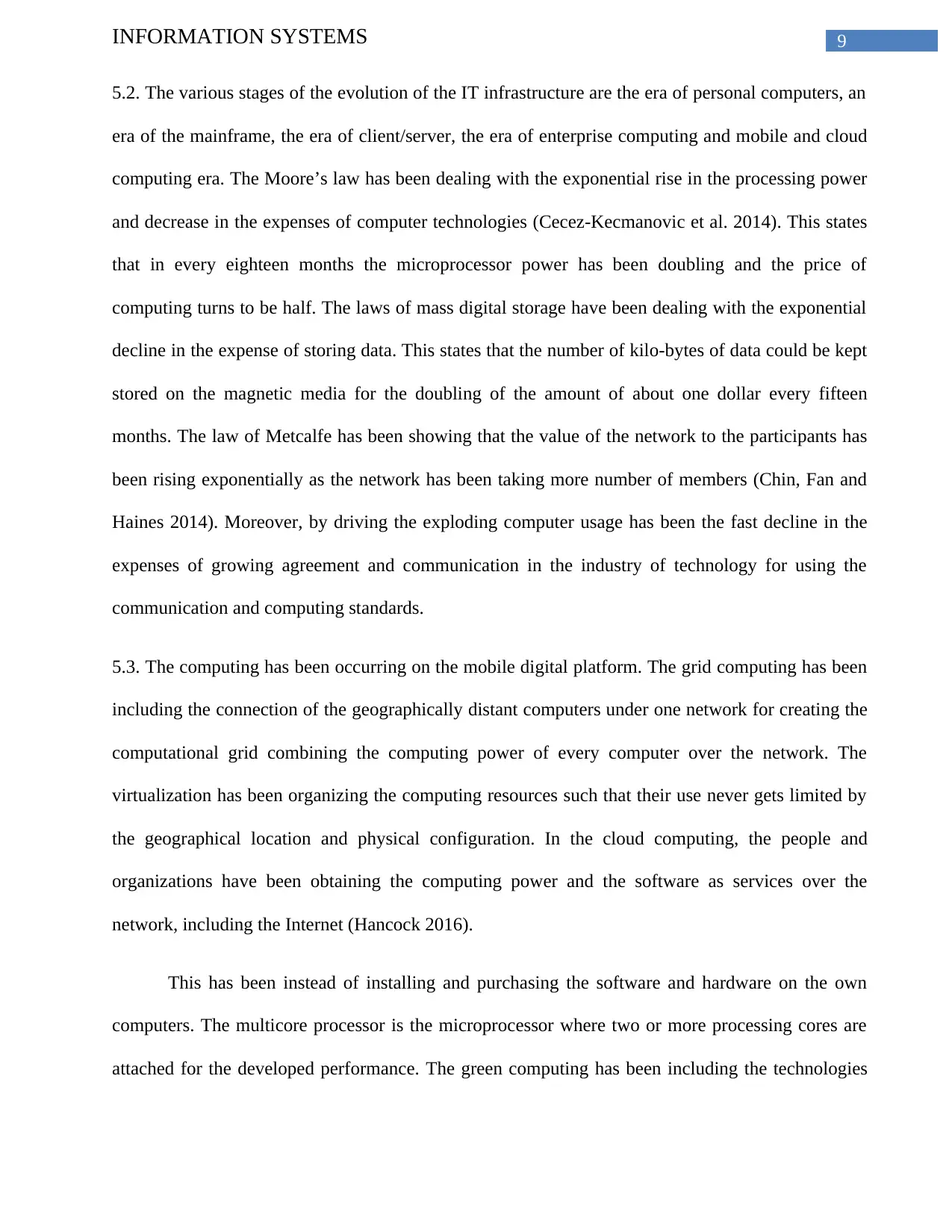
9INFORMATION SYSTEMS
5.2. The various stages of the evolution of the IT infrastructure are the era of personal computers, an
era of the mainframe, the era of client/server, the era of enterprise computing and mobile and cloud
computing era. The Moore’s law has been dealing with the exponential rise in the processing power
and decrease in the expenses of computer technologies (Cecez-Kecmanovic et al. 2014). This states
that in every eighteen months the microprocessor power has been doubling and the price of
computing turns to be half. The laws of mass digital storage have been dealing with the exponential
decline in the expense of storing data. This states that the number of kilo-bytes of data could be kept
stored on the magnetic media for the doubling of the amount of about one dollar every fifteen
months. The law of Metcalfe has been showing that the value of the network to the participants has
been rising exponentially as the network has been taking more number of members (Chin, Fan and
Haines 2014). Moreover, by driving the exploding computer usage has been the fast decline in the
expenses of growing agreement and communication in the industry of technology for using the
communication and computing standards.
5.3. The computing has been occurring on the mobile digital platform. The grid computing has been
including the connection of the geographically distant computers under one network for creating the
computational grid combining the computing power of every computer over the network. The
virtualization has been organizing the computing resources such that their use never gets limited by
the geographical location and physical configuration. In the cloud computing, the people and
organizations have been obtaining the computing power and the software as services over the
network, including the Internet (Hancock 2016).
This has been instead of installing and purchasing the software and hardware on the own
computers. The multicore processor is the microprocessor where two or more processing cores are
attached for the developed performance. The green computing has been including the technologies
5.2. The various stages of the evolution of the IT infrastructure are the era of personal computers, an
era of the mainframe, the era of client/server, the era of enterprise computing and mobile and cloud
computing era. The Moore’s law has been dealing with the exponential rise in the processing power
and decrease in the expenses of computer technologies (Cecez-Kecmanovic et al. 2014). This states
that in every eighteen months the microprocessor power has been doubling and the price of
computing turns to be half. The laws of mass digital storage have been dealing with the exponential
decline in the expense of storing data. This states that the number of kilo-bytes of data could be kept
stored on the magnetic media for the doubling of the amount of about one dollar every fifteen
months. The law of Metcalfe has been showing that the value of the network to the participants has
been rising exponentially as the network has been taking more number of members (Chin, Fan and
Haines 2014). Moreover, by driving the exploding computer usage has been the fast decline in the
expenses of growing agreement and communication in the industry of technology for using the
communication and computing standards.
5.3. The computing has been occurring on the mobile digital platform. The grid computing has been
including the connection of the geographically distant computers under one network for creating the
computational grid combining the computing power of every computer over the network. The
virtualization has been organizing the computing resources such that their use never gets limited by
the geographical location and physical configuration. In the cloud computing, the people and
organizations have been obtaining the computing power and the software as services over the
network, including the Internet (Hancock 2016).
This has been instead of installing and purchasing the software and hardware on the own
computers. The multicore processor is the microprocessor where two or more processing cores are
attached for the developed performance. The green computing has been including the technologies
Secure Best Marks with AI Grader
Need help grading? Try our AI Grader for instant feedback on your assignments.
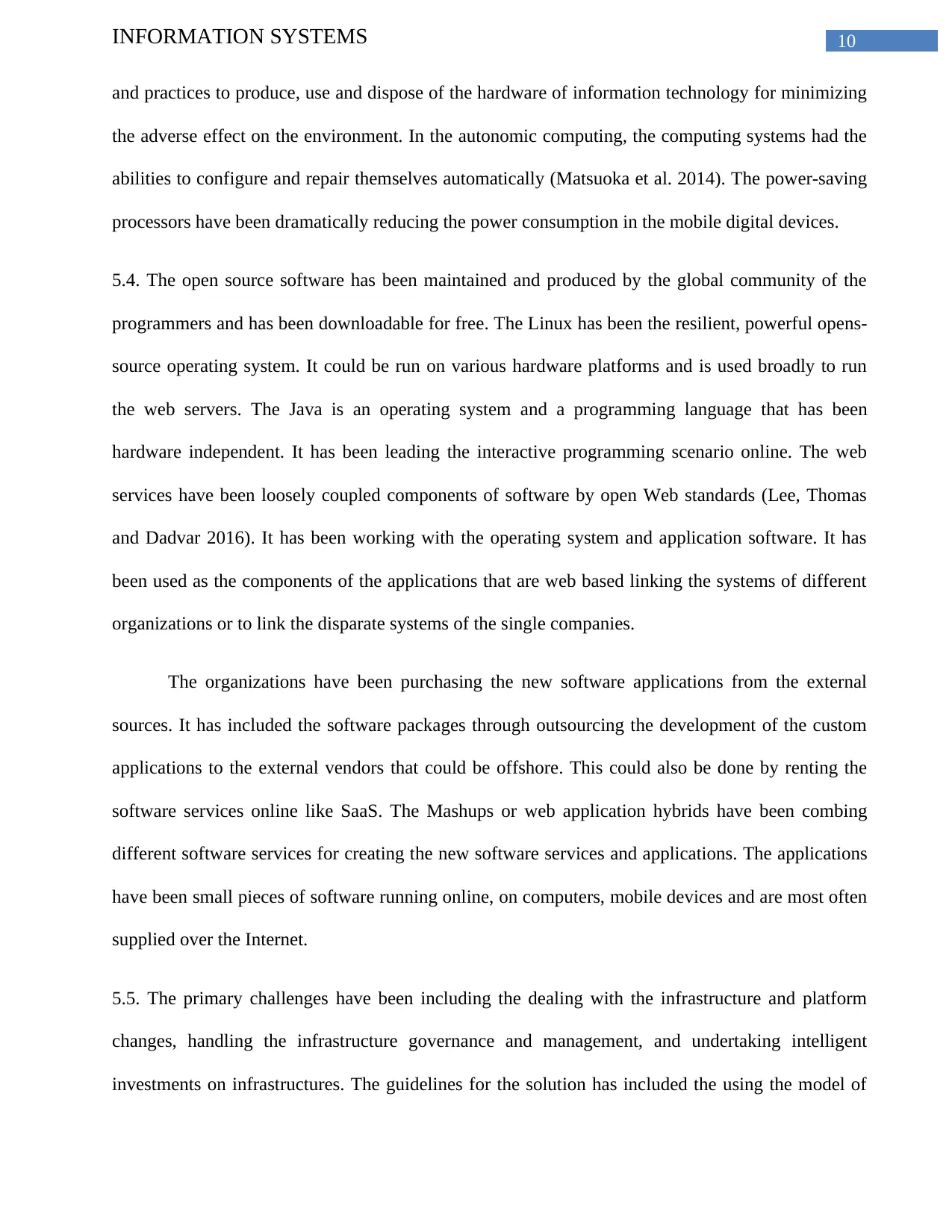
10INFORMATION SYSTEMS
and practices to produce, use and dispose of the hardware of information technology for minimizing
the adverse effect on the environment. In the autonomic computing, the computing systems had the
abilities to configure and repair themselves automatically (Matsuoka et al. 2014). The power-saving
processors have been dramatically reducing the power consumption in the mobile digital devices.
5.4. The open source software has been maintained and produced by the global community of the
programmers and has been downloadable for free. The Linux has been the resilient, powerful opens-
source operating system. It could be run on various hardware platforms and is used broadly to run
the web servers. The Java is an operating system and a programming language that has been
hardware independent. It has been leading the interactive programming scenario online. The web
services have been loosely coupled components of software by open Web standards (Lee, Thomas
and Dadvar 2016). It has been working with the operating system and application software. It has
been used as the components of the applications that are web based linking the systems of different
organizations or to link the disparate systems of the single companies.
The organizations have been purchasing the new software applications from the external
sources. It has included the software packages through outsourcing the development of the custom
applications to the external vendors that could be offshore. This could also be done by renting the
software services online like SaaS. The Mashups or web application hybrids have been combing
different software services for creating the new software services and applications. The applications
have been small pieces of software running online, on computers, mobile devices and are most often
supplied over the Internet.
5.5. The primary challenges have been including the dealing with the infrastructure and platform
changes, handling the infrastructure governance and management, and undertaking intelligent
investments on infrastructures. The guidelines for the solution has included the using the model of
and practices to produce, use and dispose of the hardware of information technology for minimizing
the adverse effect on the environment. In the autonomic computing, the computing systems had the
abilities to configure and repair themselves automatically (Matsuoka et al. 2014). The power-saving
processors have been dramatically reducing the power consumption in the mobile digital devices.
5.4. The open source software has been maintained and produced by the global community of the
programmers and has been downloadable for free. The Linux has been the resilient, powerful opens-
source operating system. It could be run on various hardware platforms and is used broadly to run
the web servers. The Java is an operating system and a programming language that has been
hardware independent. It has been leading the interactive programming scenario online. The web
services have been loosely coupled components of software by open Web standards (Lee, Thomas
and Dadvar 2016). It has been working with the operating system and application software. It has
been used as the components of the applications that are web based linking the systems of different
organizations or to link the disparate systems of the single companies.
The organizations have been purchasing the new software applications from the external
sources. It has included the software packages through outsourcing the development of the custom
applications to the external vendors that could be offshore. This could also be done by renting the
software services online like SaaS. The Mashups or web application hybrids have been combing
different software services for creating the new software services and applications. The applications
have been small pieces of software running online, on computers, mobile devices and are most often
supplied over the Internet.
5.5. The primary challenges have been including the dealing with the infrastructure and platform
changes, handling the infrastructure governance and management, and undertaking intelligent
investments on infrastructures. The guidelines for the solution has included the using the model of
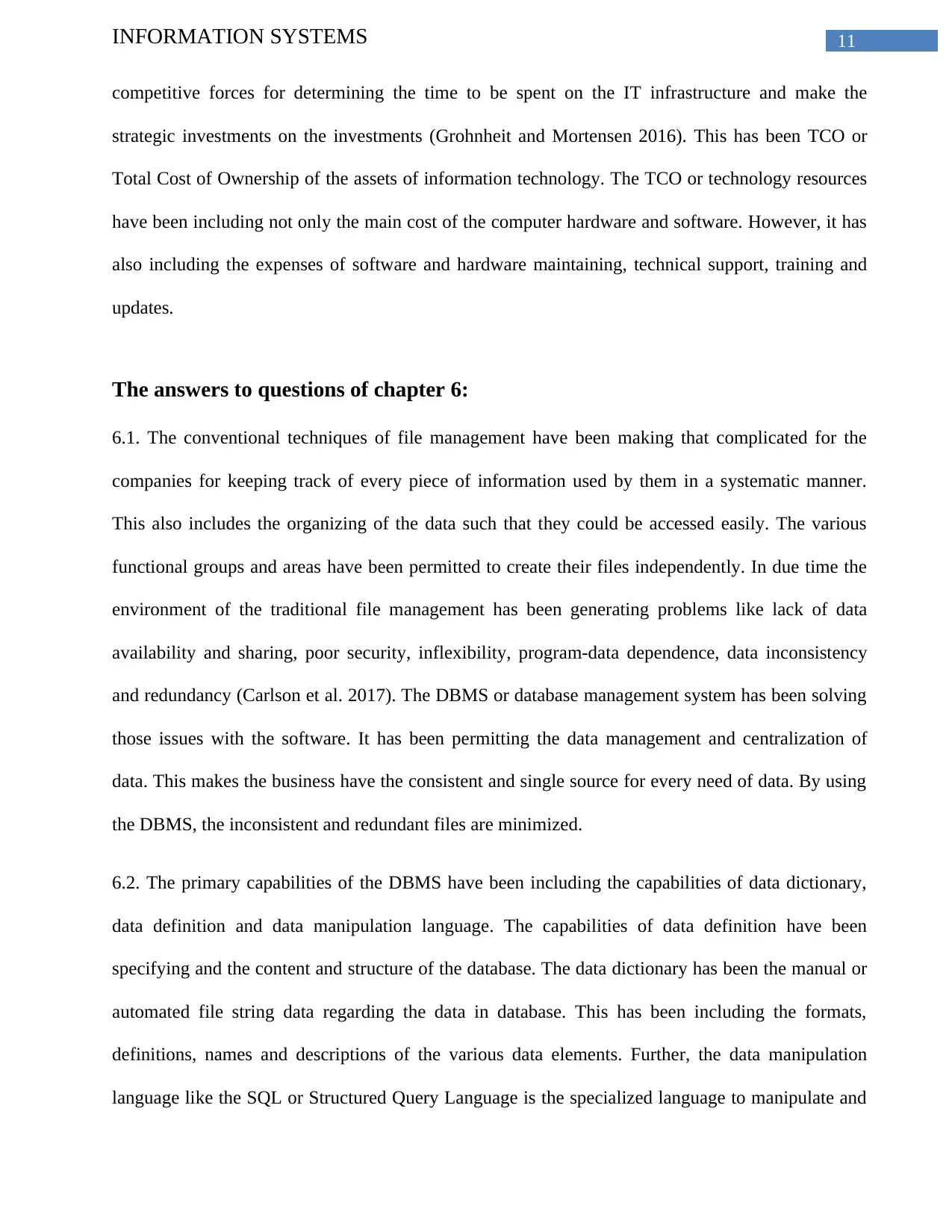
11INFORMATION SYSTEMS
competitive forces for determining the time to be spent on the IT infrastructure and make the
strategic investments on the investments (Grohnheit and Mortensen 2016). This has been TCO or
Total Cost of Ownership of the assets of information technology. The TCO or technology resources
have been including not only the main cost of the computer hardware and software. However, it has
also including the expenses of software and hardware maintaining, technical support, training and
updates.
The answers to questions of chapter 6:
6.1. The conventional techniques of file management have been making that complicated for the
companies for keeping track of every piece of information used by them in a systematic manner.
This also includes the organizing of the data such that they could be accessed easily. The various
functional groups and areas have been permitted to create their files independently. In due time the
environment of the traditional file management has been generating problems like lack of data
availability and sharing, poor security, inflexibility, program-data dependence, data inconsistency
and redundancy (Carlson et al. 2017). The DBMS or database management system has been solving
those issues with the software. It has been permitting the data management and centralization of
data. This makes the business have the consistent and single source for every need of data. By using
the DBMS, the inconsistent and redundant files are minimized.
6.2. The primary capabilities of the DBMS have been including the capabilities of data dictionary,
data definition and data manipulation language. The capabilities of data definition have been
specifying and the content and structure of the database. The data dictionary has been the manual or
automated file string data regarding the data in database. This has been including the formats,
definitions, names and descriptions of the various data elements. Further, the data manipulation
language like the SQL or Structured Query Language is the specialized language to manipulate and
competitive forces for determining the time to be spent on the IT infrastructure and make the
strategic investments on the investments (Grohnheit and Mortensen 2016). This has been TCO or
Total Cost of Ownership of the assets of information technology. The TCO or technology resources
have been including not only the main cost of the computer hardware and software. However, it has
also including the expenses of software and hardware maintaining, technical support, training and
updates.
The answers to questions of chapter 6:
6.1. The conventional techniques of file management have been making that complicated for the
companies for keeping track of every piece of information used by them in a systematic manner.
This also includes the organizing of the data such that they could be accessed easily. The various
functional groups and areas have been permitted to create their files independently. In due time the
environment of the traditional file management has been generating problems like lack of data
availability and sharing, poor security, inflexibility, program-data dependence, data inconsistency
and redundancy (Carlson et al. 2017). The DBMS or database management system has been solving
those issues with the software. It has been permitting the data management and centralization of
data. This makes the business have the consistent and single source for every need of data. By using
the DBMS, the inconsistent and redundant files are minimized.
6.2. The primary capabilities of the DBMS have been including the capabilities of data dictionary,
data definition and data manipulation language. The capabilities of data definition have been
specifying and the content and structure of the database. The data dictionary has been the manual or
automated file string data regarding the data in database. This has been including the formats,
definitions, names and descriptions of the various data elements. Further, the data manipulation
language like the SQL or Structured Query Language is the specialized language to manipulate and
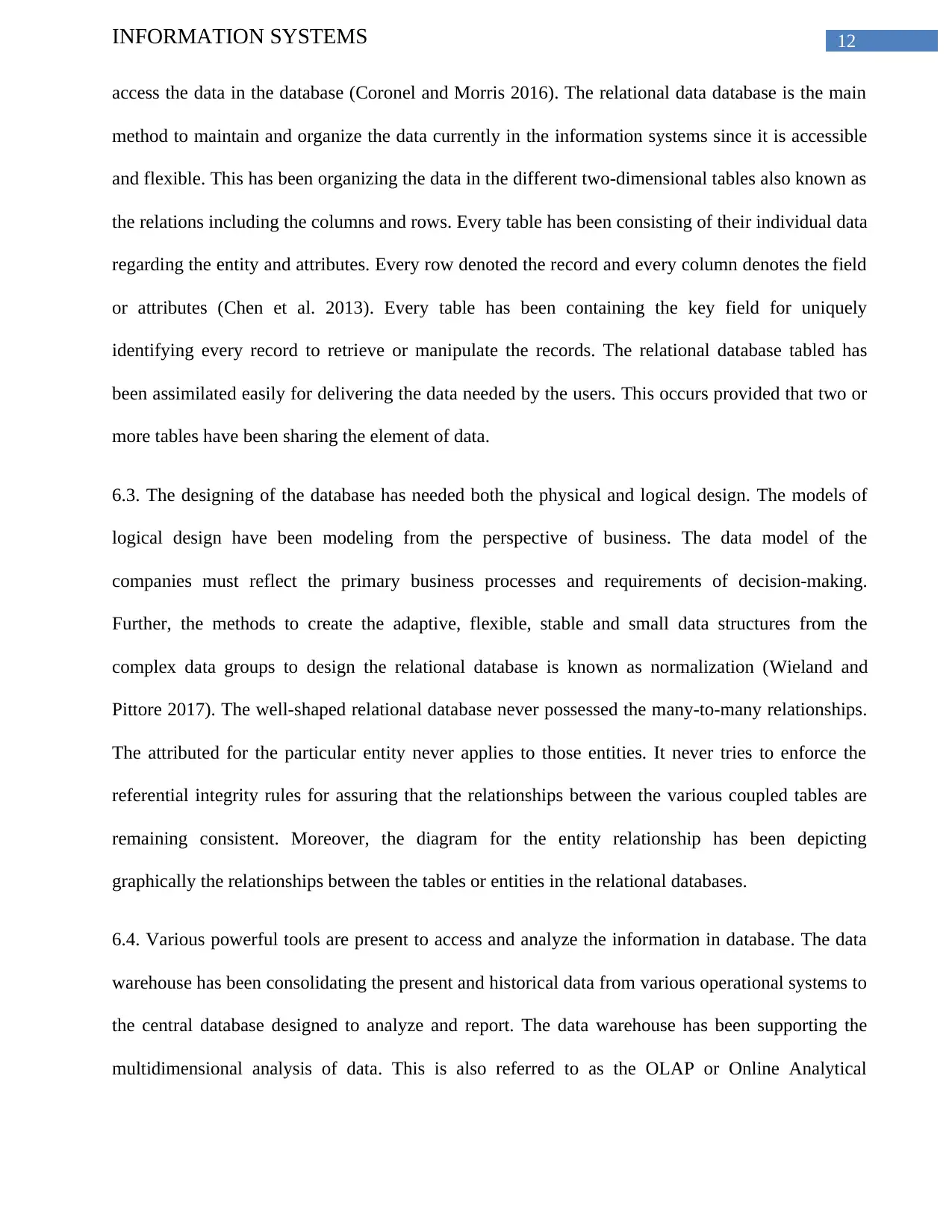
12INFORMATION SYSTEMS
access the data in the database (Coronel and Morris 2016). The relational data database is the main
method to maintain and organize the data currently in the information systems since it is accessible
and flexible. This has been organizing the data in the different two-dimensional tables also known as
the relations including the columns and rows. Every table has been consisting of their individual data
regarding the entity and attributes. Every row denoted the record and every column denotes the field
or attributes (Chen et al. 2013). Every table has been containing the key field for uniquely
identifying every record to retrieve or manipulate the records. The relational database tabled has
been assimilated easily for delivering the data needed by the users. This occurs provided that two or
more tables have been sharing the element of data.
6.3. The designing of the database has needed both the physical and logical design. The models of
logical design have been modeling from the perspective of business. The data model of the
companies must reflect the primary business processes and requirements of decision-making.
Further, the methods to create the adaptive, flexible, stable and small data structures from the
complex data groups to design the relational database is known as normalization (Wieland and
Pittore 2017). The well-shaped relational database never possessed the many-to-many relationships.
The attributed for the particular entity never applies to those entities. It never tries to enforce the
referential integrity rules for assuring that the relationships between the various coupled tables are
remaining consistent. Moreover, the diagram for the entity relationship has been depicting
graphically the relationships between the tables or entities in the relational databases.
6.4. Various powerful tools are present to access and analyze the information in database. The data
warehouse has been consolidating the present and historical data from various operational systems to
the central database designed to analyze and report. The data warehouse has been supporting the
multidimensional analysis of data. This is also referred to as the OLAP or Online Analytical
access the data in the database (Coronel and Morris 2016). The relational data database is the main
method to maintain and organize the data currently in the information systems since it is accessible
and flexible. This has been organizing the data in the different two-dimensional tables also known as
the relations including the columns and rows. Every table has been consisting of their individual data
regarding the entity and attributes. Every row denoted the record and every column denotes the field
or attributes (Chen et al. 2013). Every table has been containing the key field for uniquely
identifying every record to retrieve or manipulate the records. The relational database tabled has
been assimilated easily for delivering the data needed by the users. This occurs provided that two or
more tables have been sharing the element of data.
6.3. The designing of the database has needed both the physical and logical design. The models of
logical design have been modeling from the perspective of business. The data model of the
companies must reflect the primary business processes and requirements of decision-making.
Further, the methods to create the adaptive, flexible, stable and small data structures from the
complex data groups to design the relational database is known as normalization (Wieland and
Pittore 2017). The well-shaped relational database never possessed the many-to-many relationships.
The attributed for the particular entity never applies to those entities. It never tries to enforce the
referential integrity rules for assuring that the relationships between the various coupled tables are
remaining consistent. Moreover, the diagram for the entity relationship has been depicting
graphically the relationships between the tables or entities in the relational databases.
6.4. Various powerful tools are present to access and analyze the information in database. The data
warehouse has been consolidating the present and historical data from various operational systems to
the central database designed to analyze and report. The data warehouse has been supporting the
multidimensional analysis of data. This is also referred to as the OLAP or Online Analytical
Paraphrase This Document
Need a fresh take? Get an instant paraphrase of this document with our AI Paraphraser
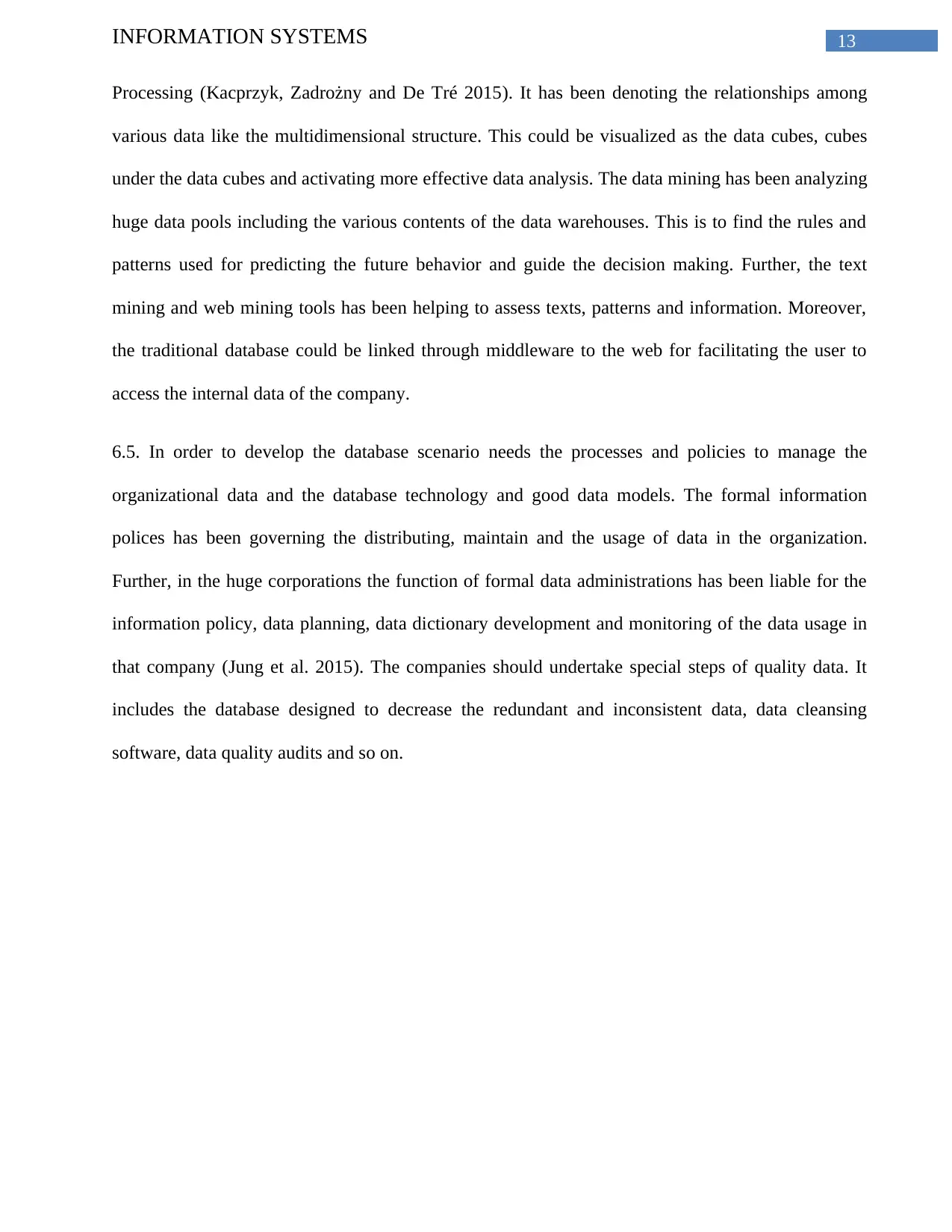
13INFORMATION SYSTEMS
Processing (Kacprzyk, Zadrożny and De Tré 2015). It has been denoting the relationships among
various data like the multidimensional structure. This could be visualized as the data cubes, cubes
under the data cubes and activating more effective data analysis. The data mining has been analyzing
huge data pools including the various contents of the data warehouses. This is to find the rules and
patterns used for predicting the future behavior and guide the decision making. Further, the text
mining and web mining tools has been helping to assess texts, patterns and information. Moreover,
the traditional database could be linked through middleware to the web for facilitating the user to
access the internal data of the company.
6.5. In order to develop the database scenario needs the processes and policies to manage the
organizational data and the database technology and good data models. The formal information
polices has been governing the distributing, maintain and the usage of data in the organization.
Further, in the huge corporations the function of formal data administrations has been liable for the
information policy, data planning, data dictionary development and monitoring of the data usage in
that company (Jung et al. 2015). The companies should undertake special steps of quality data. It
includes the database designed to decrease the redundant and inconsistent data, data cleansing
software, data quality audits and so on.
Processing (Kacprzyk, Zadrożny and De Tré 2015). It has been denoting the relationships among
various data like the multidimensional structure. This could be visualized as the data cubes, cubes
under the data cubes and activating more effective data analysis. The data mining has been analyzing
huge data pools including the various contents of the data warehouses. This is to find the rules and
patterns used for predicting the future behavior and guide the decision making. Further, the text
mining and web mining tools has been helping to assess texts, patterns and information. Moreover,
the traditional database could be linked through middleware to the web for facilitating the user to
access the internal data of the company.
6.5. In order to develop the database scenario needs the processes and policies to manage the
organizational data and the database technology and good data models. The formal information
polices has been governing the distributing, maintain and the usage of data in the organization.
Further, in the huge corporations the function of formal data administrations has been liable for the
information policy, data planning, data dictionary development and monitoring of the data usage in
that company (Jung et al. 2015). The companies should undertake special steps of quality data. It
includes the database designed to decrease the redundant and inconsistent data, data cleansing
software, data quality audits and so on.
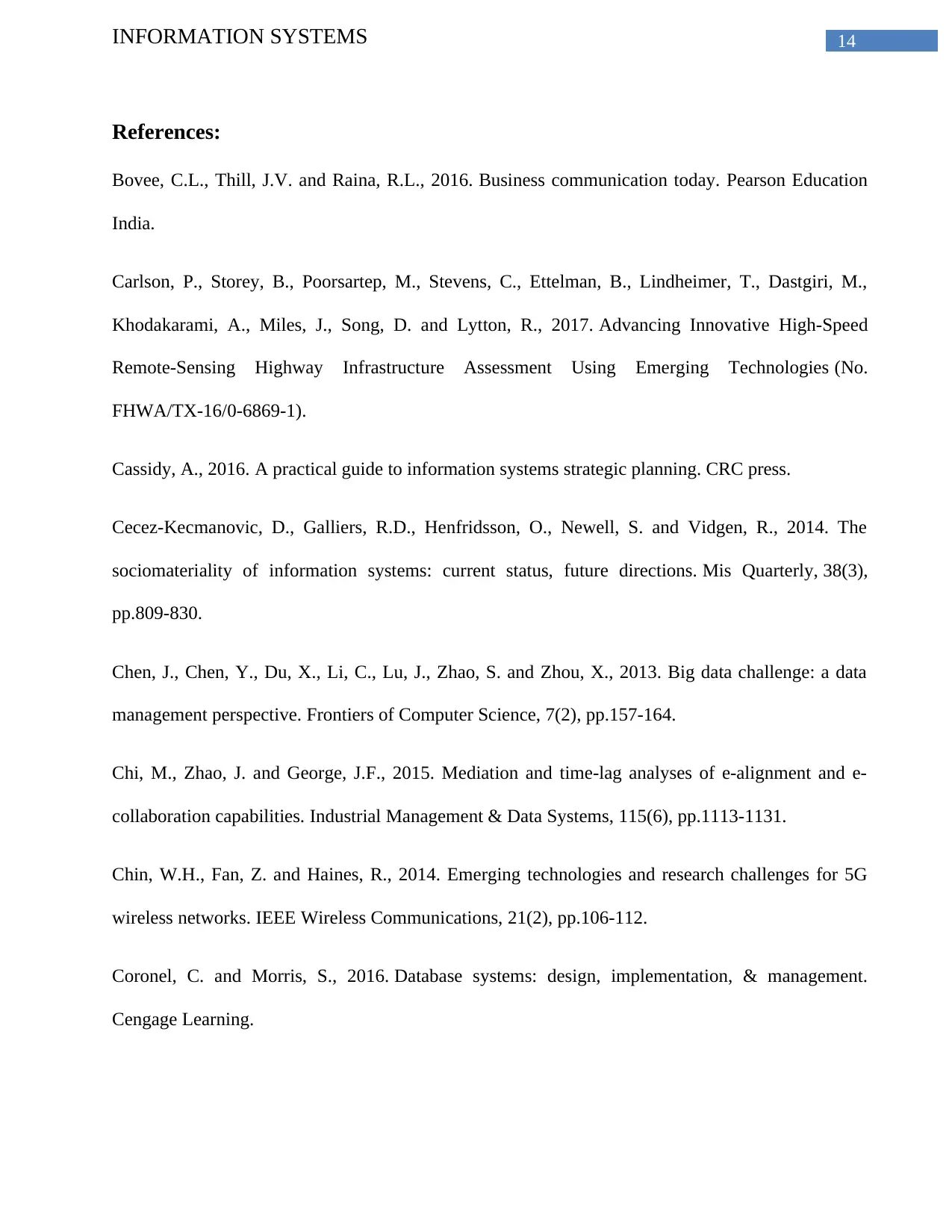
14INFORMATION SYSTEMS
References:
Bovee, C.L., Thill, J.V. and Raina, R.L., 2016. Business communication today. Pearson Education
India.
Carlson, P., Storey, B., Poorsartep, M., Stevens, C., Ettelman, B., Lindheimer, T., Dastgiri, M.,
Khodakarami, A., Miles, J., Song, D. and Lytton, R., 2017. Advancing Innovative High-Speed
Remote-Sensing Highway Infrastructure Assessment Using Emerging Technologies (No.
FHWA/TX-16/0-6869-1).
Cassidy, A., 2016. A practical guide to information systems strategic planning. CRC press.
Cecez-Kecmanovic, D., Galliers, R.D., Henfridsson, O., Newell, S. and Vidgen, R., 2014. The
sociomateriality of information systems: current status, future directions. Mis Quarterly, 38(3),
pp.809-830.
Chen, J., Chen, Y., Du, X., Li, C., Lu, J., Zhao, S. and Zhou, X., 2013. Big data challenge: a data
management perspective. Frontiers of Computer Science, 7(2), pp.157-164.
Chi, M., Zhao, J. and George, J.F., 2015. Mediation and time-lag analyses of e-alignment and e-
collaboration capabilities. Industrial Management & Data Systems, 115(6), pp.1113-1131.
Chin, W.H., Fan, Z. and Haines, R., 2014. Emerging technologies and research challenges for 5G
wireless networks. IEEE Wireless Communications, 21(2), pp.106-112.
Coronel, C. and Morris, S., 2016. Database systems: design, implementation, & management.
Cengage Learning.
References:
Bovee, C.L., Thill, J.V. and Raina, R.L., 2016. Business communication today. Pearson Education
India.
Carlson, P., Storey, B., Poorsartep, M., Stevens, C., Ettelman, B., Lindheimer, T., Dastgiri, M.,
Khodakarami, A., Miles, J., Song, D. and Lytton, R., 2017. Advancing Innovative High-Speed
Remote-Sensing Highway Infrastructure Assessment Using Emerging Technologies (No.
FHWA/TX-16/0-6869-1).
Cassidy, A., 2016. A practical guide to information systems strategic planning. CRC press.
Cecez-Kecmanovic, D., Galliers, R.D., Henfridsson, O., Newell, S. and Vidgen, R., 2014. The
sociomateriality of information systems: current status, future directions. Mis Quarterly, 38(3),
pp.809-830.
Chen, J., Chen, Y., Du, X., Li, C., Lu, J., Zhao, S. and Zhou, X., 2013. Big data challenge: a data
management perspective. Frontiers of Computer Science, 7(2), pp.157-164.
Chi, M., Zhao, J. and George, J.F., 2015. Mediation and time-lag analyses of e-alignment and e-
collaboration capabilities. Industrial Management & Data Systems, 115(6), pp.1113-1131.
Chin, W.H., Fan, Z. and Haines, R., 2014. Emerging technologies and research challenges for 5G
wireless networks. IEEE Wireless Communications, 21(2), pp.106-112.
Coronel, C. and Morris, S., 2016. Database systems: design, implementation, & management.
Cengage Learning.

15INFORMATION SYSTEMS
Gouda, H.N., Flaxman, A., Brolan, C.E., Joshi, R., Riley, I.D., AbouZahr, C., Firth, S., Rampatige,
R. and Lopez, A.D., 2017. New challenges for verbal autopsy: Considering the ethical and social
implications of verbal autopsy methods in routine health information systems. Social Science &
Medicine.
Grohnheit, P.E. and Mortensen, B.O.G., 2016. District heating as the infrastructure for competition
among fuels and technologies. Journal of Energy Challenges and Mechanics, 3(2), pp.64-69.
Hancock, K., 2016. Applications of Connected Vehicle Infrastructure Technologies to Enhance
Transit Service Efficiency and Safety, Part 1.
Jung, J.W., Jung, S.K., Choi, J.T. and Lee, D.S., 2015. A study on Standardization of Integrated
database for Intelligent water information management.
Kacprzyk, J., Zadrożny, S. and De Tré, G., 2015. Fuzziness in database management systems. Fuzzy
Sets and Systems, 281(C), pp.300-307.
Kosinski, M., Matz, S.C., Gosling, S.D., Popov, V. and Stillwell, D., 2015. Facebook as a research
tool for the social sciences: Opportunities, challenges, ethical considerations, and practical
guidelines. American Psychologist, 70(6), p.543.
Laudon, K.C. and Laudon, J.P., 2015. Management Information Systems: Managing the Digital Firm
Plus MyMISLab with Pearson eText--Access Card Package. Prentice Hall Press.
Laudon, K.C. and Laudon, J.P., 2016. Management information system. Pearson Education India.
Lee, Y.J., Thomas, C. and Dadvar, S., 2016. Applications of Connected Vehicle Infrastructure
Technologies to Enhance Transit Service Efficiency and Safety, Part 2.
Gouda, H.N., Flaxman, A., Brolan, C.E., Joshi, R., Riley, I.D., AbouZahr, C., Firth, S., Rampatige,
R. and Lopez, A.D., 2017. New challenges for verbal autopsy: Considering the ethical and social
implications of verbal autopsy methods in routine health information systems. Social Science &
Medicine.
Grohnheit, P.E. and Mortensen, B.O.G., 2016. District heating as the infrastructure for competition
among fuels and technologies. Journal of Energy Challenges and Mechanics, 3(2), pp.64-69.
Hancock, K., 2016. Applications of Connected Vehicle Infrastructure Technologies to Enhance
Transit Service Efficiency and Safety, Part 1.
Jung, J.W., Jung, S.K., Choi, J.T. and Lee, D.S., 2015. A study on Standardization of Integrated
database for Intelligent water information management.
Kacprzyk, J., Zadrożny, S. and De Tré, G., 2015. Fuzziness in database management systems. Fuzzy
Sets and Systems, 281(C), pp.300-307.
Kosinski, M., Matz, S.C., Gosling, S.D., Popov, V. and Stillwell, D., 2015. Facebook as a research
tool for the social sciences: Opportunities, challenges, ethical considerations, and practical
guidelines. American Psychologist, 70(6), p.543.
Laudon, K.C. and Laudon, J.P., 2015. Management Information Systems: Managing the Digital Firm
Plus MyMISLab with Pearson eText--Access Card Package. Prentice Hall Press.
Laudon, K.C. and Laudon, J.P., 2016. Management information system. Pearson Education India.
Lee, Y.J., Thomas, C. and Dadvar, S., 2016. Applications of Connected Vehicle Infrastructure
Technologies to Enhance Transit Service Efficiency and Safety, Part 2.
Secure Best Marks with AI Grader
Need help grading? Try our AI Grader for instant feedback on your assignments.

16INFORMATION SYSTEMS
Matsuoka, S., Sato, H., Tatebe, O., Koibuchi, M., Fujiwara, I., Suzuki, S., Kakuta, M., Ishida, T.,
Akiyama, Y., Suzumura, T. and Ueno, K., 2014. Extreme Big Data (EBD): Next generation big data
infrastructure technologies towards yottabyte/year. Supercomputing frontiers and innovations, 1(2),
pp.89-107.
McKee, R., 2013. Ethical issues in using social media for health and health care research. Health
Policy, 110(2), pp.298-301.
Nof, S.Y., Ceroni, J., Jeong, W. and Moghaddam, M., 2015. Revolutionizing Collaboration through
e-Work, e-Business, and e-Service (Vol. 2). Springer.
Pearlson, K.E., Saunders, C.S. and Galletta, D.F., 2016. Managing and Using Information Systems,
Binder Ready Version: A Strategic Approach. John Wiley & Sons.
Peppard, J. and Ward, J., 2016. The strategic management of information systems: Building a digital
strategy. John Wiley & Sons.
Soto-Acosta, P., Popa, S. and Palacios-Marqués, D., 2016. E-business, organizational innovation and
firm performance in manufacturing SMEs: an empirical study in Spain. Technological and
Economic Development of Economy, 22(6), pp.885-904.
Wieland, M. and Pittore, M., 2017. A Spatio-Temporal Building Exposure Database and Information
Life-Cycle Management Solution. ISPRS International Journal of Geo-Information, 6(4), p.114.
Wiengarten, F., Humphreys, P., McKittrick, A. and Fynes, B., 2013. Investigating the impact of e-
business applications on supply chain collaboration in the German automotive industry. International
Journal of Operations & Production Management, 33(1), pp.25-48.
Matsuoka, S., Sato, H., Tatebe, O., Koibuchi, M., Fujiwara, I., Suzuki, S., Kakuta, M., Ishida, T.,
Akiyama, Y., Suzumura, T. and Ueno, K., 2014. Extreme Big Data (EBD): Next generation big data
infrastructure technologies towards yottabyte/year. Supercomputing frontiers and innovations, 1(2),
pp.89-107.
McKee, R., 2013. Ethical issues in using social media for health and health care research. Health
Policy, 110(2), pp.298-301.
Nof, S.Y., Ceroni, J., Jeong, W. and Moghaddam, M., 2015. Revolutionizing Collaboration through
e-Work, e-Business, and e-Service (Vol. 2). Springer.
Pearlson, K.E., Saunders, C.S. and Galletta, D.F., 2016. Managing and Using Information Systems,
Binder Ready Version: A Strategic Approach. John Wiley & Sons.
Peppard, J. and Ward, J., 2016. The strategic management of information systems: Building a digital
strategy. John Wiley & Sons.
Soto-Acosta, P., Popa, S. and Palacios-Marqués, D., 2016. E-business, organizational innovation and
firm performance in manufacturing SMEs: an empirical study in Spain. Technological and
Economic Development of Economy, 22(6), pp.885-904.
Wieland, M. and Pittore, M., 2017. A Spatio-Temporal Building Exposure Database and Information
Life-Cycle Management Solution. ISPRS International Journal of Geo-Information, 6(4), p.114.
Wiengarten, F., Humphreys, P., McKittrick, A. and Fynes, B., 2013. Investigating the impact of e-
business applications on supply chain collaboration in the German automotive industry. International
Journal of Operations & Production Management, 33(1), pp.25-48.

17INFORMATION SYSTEMS
1 out of 18
Related Documents
Your All-in-One AI-Powered Toolkit for Academic Success.
+13062052269
info@desklib.com
Available 24*7 on WhatsApp / Email
![[object Object]](/_next/static/media/star-bottom.7253800d.svg)
Unlock your academic potential
© 2024 | Zucol Services PVT LTD | All rights reserved.




